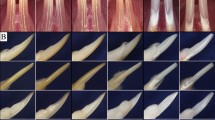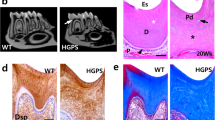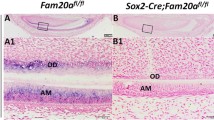Abstract
Patients with mild forms of peroxisomal biogenesis disorders show facial dysmorphism and exhibit dentition problems accompanied by enamel hypoplasia. However, no information is available on the role of peroxisomes in dental and paradontal tissues. Therefore, we studied the distribution of these organelles, their protein composition and the expression of corresponding genes during dental development and in mature decalcified teeth in mice. Perfusion-fixed heads of mice of different developmental stages (E13.5 to adult) were cut in sagittal direction into two halves and embedded in paraffin for serial sectioning and subsequent peroxidase-based immunohistochemistry or double-immunofluorescence preparations. Frozen, unfixed heads of newborn mice were used for cryosectioning and subsequent laser-assisted microdissection of ameloblasts and odontoblasts, RNA isolation and RT-PCR analysis. Our results revealed the presence of peroxisomes already in the bud stage of dental development. An increase in peroxisome abundance was noted during differentiation of ameloblasts and odontoblasts with the highest number of organelles in Tomes’ processes of mature ameloblasts. A strong heterogeneity of peroxisomal enzyme content developed within differentiated dental cell types. A drastic down-regulation of catalase in maturing ameloblasts was noted in contrast to high levels of lipid metabolizing enzymes in peroxisomes of these cells. As known from the literature, differentiated ameloblasts are more prone to oxidative damage which could be explained by the low catalase levels inside of this cell type.






Similar content being viewed by others
Abbreviations
- PFA:
-
Paraformaldehyde
- PBS:
-
Phosphate-buffered saline
- CAT:
-
Catalase
- ROS:
-
Reactive oxygen species
References
Ahlemeyer B, Neubert I, Kovacs WJ, Baumgart-Vogt E (2007) Differential expression of peroxisomal matrix and membrane proteins during postnatal development of mouse brain. J Comp Neurol 505:1–17
Baes M, Gressens P, Baumgart E, Carmeliet P, Casteels M, Fransen M, Evrard P, Fahimi D, Declercq PE, Collen D, van Veldhoven PP, Mannaerts GP (1997) A mouse model for Zellweger syndrome. Nat Genet 17:49–57
Baumgart E, Fahimi HD, Steininger H, Grabenbauer M (2003) A review of morphological techniques for detection of peroxisomal (and mitochondrial) proteins and their corresponding mRNAs during ontogenesis in mice: application to the PEX5-knockout mouse with Zellweger syndrome. Microsc Res Tech 61:121–138
Braverman N, Zhang R, Chen L, Nimmo G, Scheper S, Tran T, Chaudhury R, Moser A, Steinberg S (2010) A Pex7 hypomorphic mouse model for plasmalogen deficiency affecting the lens and skeleton. Mol Genet Metab 99:408–416
Couve E (1986) Ultrastructural changes during the life cycle of human odontoblasts. Arch Oral Biol 31:643–651
De Duve C (1965) The separation and characterization of subcellular particles. Harvey Lect 59:49–87
De Duve C, Baudhuin P (1966) Peroxisomes (microbodies and related particles). Physiol Rev 46:323–357
Domingues MG, Jaeger MM, Araujo VC, Araujo NS (2000) Expression of cytokeratins in human enamel organ. Eur J Oral Sci 108:43–47
Dreyer C, Krey G, Keller H, Givel F, Helftenbein G, Wahli W (1992) Control of the peroxisomal beta-oxidation pathway by a novel family of nuclear hormone receptors. Cell 68:879–887
Fahimi HD, Beier K, Lindauer M, Schad A, Zhan J, Pill J, Rebel W, Völkl A, Baumgart E (1996) Zonal heterogeneity of peroxisome proliferation in rat liver. Ann N Y Acad Sci 804:341–361
Fang Y, Morrell JC, Jones JM, Gould SJ (2004) PEX3 functions as a PEX19 docking factor in the import of class I peroxisomal membrane proteins. J Cell Biol 164:863–875
Faust PL, Hatten ME (1997) Targeted deletion of the PEX2 peroxisome assembly gene in mice provides a model for Zellweger syndrome, a human neuronal migration disorder. J Cell Biol 139:1293–1305
Fincham AG, Belcourt AB, Termine JD (1983) Molecular composition of the protein matrix of developing human dental enamel. J Dent Res 62:11–15
Fleischmannova J, Matalova E, Tucker AS, Sharpe PT (2008) Mouse models of tooth abnormalities. Eur J Oral Sci 116:1–10
Gartner J (2000) Organelle disease: peroxisomal disorders. Eur J Pediatr 159(Suppl 3):S236–S239
Goldberg M, Septier D (2002) Phospholipids in amelogenesis and dentinogenesis. Crit Rev Oral Biol Med 13:276–290
Grabenbauer M, Fahimi HD, Baumgart E (2001) Detection of peroxisomal proteins and their mRNAs in serial sections of fetal and newborn mouse organs. J Histochem Cytochem 49:155–164
Grant P, Ahlemeyer B, Karnati S, Berg T, Stelzig I, Nenicu A, Kuchelmeister K, Crane DI, Baumgart-Vogt E (2013) The biogenesis protein PEX14 is an optimal marker for the identification and localization of peroxisomes in different cell types, tissues, and species in morphological studies. Histochem Cell Biol. doi:10.1007/s00418-013-1133-6
Hashimoto T, Fujita T, Usuda N, Cook W, Qi C, Peters JM, Gonzalez FJ, Yeldandi AV, Rao MS, Reddy JK (1999) Peroxisomal and mitochondrial fatty acid beta-oxidation in mice nullizygous for both peroxisome proliferator-activated receptor alpha and peroxisomal fatty acyl-CoA oxidase. Genotype correlation with fatty liver phenotype. J Biol Chem 274:19228–19236
Hiltunen JK, Karki T, Hassinen IE, Osmundsen H (1986) beta-Oxidation of polyunsaturated fatty acids by rat liver peroxisomes. A role for 2,4-dienoyl-coenzyme A reductase in peroxisomal beta-oxidation. J Biol Chem 261:16484–16493
Hiltunen JK, Filppula SA, Koivuranta KT, Siivari K, Qin YM, Hayrinen HM (1996) Peroxisomal beta-oxidation and polyunsaturated fatty acids. Ann N Y Acad Sci 804:116–128
Hoffmann M, Olson K, Cavender A, Pasqualini R, Gaikwad J, D’Souza RN (2001) Gene expression in a pure population of odontoblasts isolated by laser-capture microdissection. J Dent Res 80:1963–1967
Huyghe S, Casteels M, Janssen A, Meulders L, Mannaerts GP, Declercq PE, Van Veldhoven PP, Baes M (2001) Prenatal and postnatal development of peroxisomal lipid-metabolizing pathways in the mouse. Biochem J 353:673–680
Immenschuh S, Baumgart-Vogt E, Tan M, Iwahara S, Ramadori G, Fahimi HD (2003) Differential cellular and subcellular localization of heme-binding protein 23/peroxiredoxin I and heme oxygenase-1 in rat liver. J Histochem Cytochem 51:1621–1631
Islinger M, Lüers GH, Zischka H, Ueffing M, Völkl A (2006) Insights into the membrane proteome of rat liver peroxisomes: microsomal glutathione-S-transferase is shared by both subcellular compartments. Proteomics 6:804–816
Jedlitschky G, Huber M, Volkl A, Muller M, Leier I, Muller J, Lehmann WD, Fahimi HD, Keppler D (1991) Peroxisomal degradation of leukotrienes by beta-oxidation from the omega-end. J Biol Chem 266:24763–24772
Josephsen K, Smith CE, Nanci A (1999) Selective but nonspecific immunolabeling of enamel protein-associated compartments by a monoclonal antibody against vimentin. J Histochem Cytochem 47:1237–1245
Kagayama M, Zhu JX, Sasano Y, Sato H, Mayanagi H (1997) Development of interglobular dentine in rat molars and its relation to maturation of enamel. Anat Embryol (Berl) 196:477–483
Karnati S, Baumgart-Vogt E (2008) Peroxisomes in mouse and human lung: their involvement in pulmonary lipid metabolism. Histochem Cell Biol 130:719–740
Karnati S, Baumgart-Vogt E (2009) Peroxisomes in airway epithelia and future prospects of these organelles for pulmonary cell biology. Histochem Cell Biol 131:447–454
Karnati S, Luers G, Pfreimer S, Baumgart-Vogt E (2013) Mammalian SOD2 is exclusively located in mitochondria and not present in peroxisomes. Histochem Cell Biol. doi:10.1007/s00418-013-1099-4
Krey G, Mahfoudi A, Wahli W (1995) Functional interactions of peroxisome proliferator-activated receptor, retinoid-X receptor, and Sp1 in the transcriptional regulation of the acyl-coenzyme-A oxidase promoter. Mol Endocrinol 9:219–231
Lawrence JW, Foxworthy PS, Perry DN, Jensen CB, Giera DD, Meador VP, Eacho PI (1995) Nafenopin-induced peroxisome proliferation in vitamin A deficient rats. Biochem Pharmacol 49:915–919
Lee DH, Lim BS, Lee YK, Yang HC (2006) Effects of hydrogen peroxide (H2O2) on alkaline phosphatase activity and matrix mineralization of odontoblast and osteoblast cell lines. Cell Biol Toxicol 22:39–46
Li X, Baumgart E, Morrell JC, Jimenez-Sanchez G, Valle D, Gould SJ (2002) PEX11 beta deficiency is lethal and impairs neuronal migration but does not abrogate peroxisome function. Mol Cell Biol 22:4358–4365
Lombardi T, Samson J, Muhlhauser J, Fiore-Donno G, Maggiano N, Castellucci M (1992) Expression of intermediate filaments and actins in human dental pulp and embryonic dental papilla. Anat Rec 234:587–592
Masters CJ (1996) Cellular signalling: the role of the peroxisome. Cell Signal 8:197–208
Maxwell M, Bjorkman J, Nguyen T, Sharp P, Finnie J, Paterson C, Tonks I, Paton BC, Kay GF, Crane DI (2003) Pex13 inactivation in the mouse disrupts peroxisome biogenesis and leads to a Zellweger syndrome phenotype. Mol Cell Biol 23:5947–5957
McLachlan JL, Smith AJ, Cooper PR (2003) Piezo-power microdissection of mature human dental tissue. Arch Oral Biol 48:731–736
Nanci A, Bendayan M, Slavkin HC (1985) Enamel protein biosynthesis and secretion in mouse incisor secretory ameloblasts as revealed by high-resolution immunocytochemistry. J Histochem Cytochem 33:1153–1160
Nenicu A, Lüers GH, Kovacs W, Otte D, Zimmer A, Bergmann M, Baumgart-Vogt E (2007) Peroxisomes in human and mouse testis: differential expression of peroxisomal proteins in germ cells and distinct somatic cell types of the testis. Biol Reprod 77:1060–1072
Noda M, Wataha JC, Lewis JB, Kaga M, Lockwood PE, Messer RL, Sano H (2005) Dental adhesive compounds alter glutathione levels but not glutathione redox balance in human THP-1 monocytic cells. J Biomed Mater Res B Appl Biomater 73:308–314
Obert M, Ahlemeyer B, Baumgart-Vogt E, Traupe H (2005) Flat-panel volumetric computed tomography: a new method for visualizing fine bone detail in living mice. J Comput Assist Tomogr 29:560–565
Oida S, Nagano T, Yamakoshi Y, Ando H, Yamada M, Fukae M (2002) Amelogenin gene expression in porcine odontoblasts. J Dent Res 81:103–108
Otsuji W, Tanase S, Yoshida S, Bawden JW (1999) The immunohistochemical localization of the interferon-gamma and granulocyte colony-stimulating factor receptors during early amelogenesis in rat molars. Arch Oral Biol 44:173–181
Poll-The BT, Gootjes J, Duran M, De Klerk JB, Wenniger-Prick LJ, Admiraal RJ, Waterham HR, Wanders RJ, Barth PG (2004) Peroxisome biogenesis disorders with prolonged survival: phenotypic expression in a cohort of 31 patients. Am J Med Genet A 126A:333–338
Provenza DV (1988) Fundamentals of oral histology and embryology. Lea & Febiger, Philadelphia
Ravindranath RM, Basilrose RM Sr, Ravindranath NH, Vaitheesvaran B (2003) Amelogenin interacts with cytokeratin-5 in ameloblasts during enamel growth. J Biol Chem 278:20293–20302
Robinson C, Briggs HD, Atkinson PJ (1981) Histology of enamel organ and chemical composition of adjacent enamel in rat incisors. Calcif Tissue Int 33:513–520
Roels F, Espeel M, Pauwels M, De Craemer D, Egberts HJ, van der Spek P (1991) Different types of peroxisomes in human duodenal epithelium. Gut 32:858–865
Ruch JV (1987) Determinisms of odontogenesis. Revis Biol Celular 14:1–99
Schrader M, Fahimi HD (2004) Mammalian peroxisomes and reactive oxygen species. Histochem Cell Biol 122:383–393
Schrader M, Thiemann M, Fahimi HD (2003) Peroxisomal motility and interaction with microtubules. Microsc Res Tech 61:171–178
Sosenko IR, Innis SM, Frank L (1991) Intralipid increases lung polyunsaturated fatty acids and protects newborn rats from oxygen toxicity. Pediatr Res 30:413–417
Spagnuolo G, Annunziata M, Rengo S (2004) Cytotoxicity and oxidative stress caused by dental adhesive systems cured with halogen and LED lights. Clin Oral Investig 8:81–85
Stier H, Fahimi HD, Van Veldhoven PP, Mannaerts GP, Volkl A, Baumgart E (1998) Maturation of peroxisomes in differentiating human hepatoblastoma cells (HepG2): possible involvement of the peroxisome proliferator-activated receptor alpha (PPAR alpha). Differentiation 64:55–66
Subramani S (2002) Hitchhiking fads en route to peroxisomes. J Cell Biol 156:415–417
Ten Cate JM (1994) In situ models, physico-chemical aspects. Adv Dent Res 8:125–133
Van Dijck PW, De Kruijff B, Van Deenen LL, De Gier J, Demel RA (1976) The preference of cholesterol for phosphatidylcholine in mixed phosphatidylcholine-phosphatidylethanolamine bilayers. Biochim Biophys Acta 455:576–587
Wanders RJ (2004) Metabolic and molecular basis of peroxisomal disorders: a review. Am J Med Genet A 126A:355–375
Wiemer EA, Wenzel T, Deerinck TJ, Ellisman MH, Subramani S (1997) Visualization of the peroxisomal compartment in living mammalian cells: dynamic behavior and association with microtubules. J Cell Biol 136:71–80
Wiese S, Gronemeyer T, Ofman R, Kunze M, Grou CP, Almeida JA, Eisenacher M, Stephan C, Hayen H, Schollenberger L, Korosec T, Waterham HR, Schliebs W, Erdmann R, Berger J, Meyer HE, Just W, Azevedo JE, Wanders RJ, Warscheid B (2007) Proteomics characterization of mouse kidney peroxisomes by tandem mass spectrometry and protein correlation profiling. Mol Cell Proteomics 6:2045–2057
Zeichner-David M, Oishi K, Su Z, Zakartchenko V, Chen LS, Arzate H, Bringas P Jr (2003) Role of Hertwig’s epithelial root sheath cells in tooth root development. Dev Dyn 228:651–663
Zoeller RA, Lake AC, Nagan N, Gaposchkin DP, Legner MA, Lieberthal W (1999) Plasmalogens as endogenous antioxidants: somatic cell mutants reveal the importance of the vinyl ether. Biochem J 338(Pt 3):769–776
Acknowledgments
The excellent technical assistance of Magdalena Gottwald is gratefully acknowledged. Further, we would like to thank Profs. Denis I.Crane, Steve Gould, Paul P. Van Veldhoven for providing us with some antibodies (see Table 1). Furthermore, we thank Dr. Martin Obert, Department of Neuroradiology of the University Hospital Marburg-Giessen for checking the decalcification of dental tissue by volumetric computer tomography (VCT). Finally, we are indebted to Michelle Woods for carefully reading and correcting the manuscript.
Author information
Authors and Affiliations
Corresponding author
Rights and permissions
About this article
Cite this article
Stelzig, I., Karnati, S., Valerius, K.P. et al. Peroxisomes in dental tissues of the mouse. Histochem Cell Biol 140, 443–462 (2013). https://doi.org/10.1007/s00418-013-1131-8
Accepted:
Published:
Issue Date:
DOI: https://doi.org/10.1007/s00418-013-1131-8




